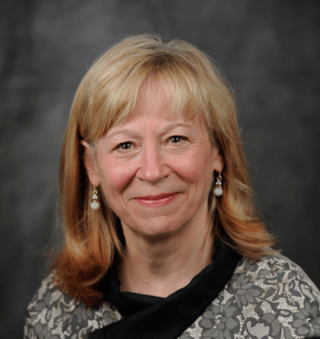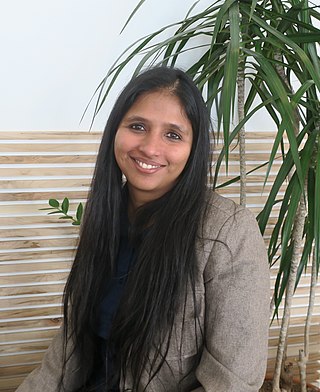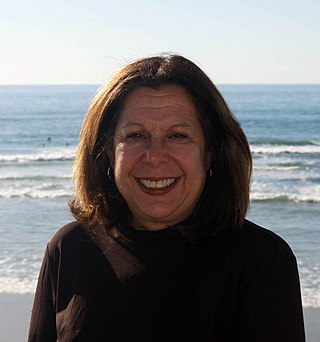Related Research Articles

Paul Hugh Emmett was an American chemist best known for his pioneering work in the field of catalysis and for his work on the Manhattan Project during World War II. He spearheaded the research to separate isotopes of uranium and to develop a corrosive uranium gas. Emmett also made significant contributions to BET Theory which explains the relationship between surface area and gas adsorption. He served on the faculty of Johns Hopkins University for 23 years throughout his scientific career.

Frank Henry Westheimer was an American chemist. He taught at the University of Chicago from 1936 to 1954, and at Harvard University from 1953 to 1983, becoming the Morris Loeb Professor of Chemistry in 1960, and Professor Emeritus in 1983. The Westheimer medal was established in his honor in 2002.
Veronica Vaida is a Romanian-Hungarian-American chemist and professor at the University of Colorado Boulder. She is an expert in environmental chemistry and aerosols.

Geraldine Lee Richmond is an American chemist and physical chemist who served as the Under Secretary of Energy for Science in the US Department of Energy from 2021 to 2025. Richmond was unanimously confirmed by the United States Senate to her role on November 5, 2021. In this position, she oversees the Office of Science, the Applied Energy offices, and 13 of the 17 Department of Energy national laboratories. Before this appointment, Richmond served as a Professor of Physical Chemistry and held the Presidential Chair in Science at the University of Oregon. Her research has focused on understanding the chemistry and physics of complex surfaces and interfaces, using laser-based experimental and theoretical computational methods. These understandings are most relevant to energy production, atmospheric chemistry and remediation of the environment. Throughout her career she has also worked to increase the number and success of women scientists in the U.S. and in many developing countries through the COACh program that she founded in 1999. She is a member of the National Academy of Sciences and the American Academy of Arts and Sciences. In recognition of her scientific achievements and contributions to women in science, she received the National Medal of Science from President Obama in 2013.
Heather Cecile Allen is a research chemist and Professor of Chemistry, who leads the Allen Group at The Ohio State University. Allen's research focuses on interfacial phenomena, particularly those involving water and air. Her work has broad application ranging from medicine to climate change. She also develops nonlinear optical spectroscopy and microscopy instruments for the examination of interfacial surfaces.
Barbara J. Finlayson-Pitts is a Canadian-American atmospheric chemist. She is a professor in the chemistry department at the University of California, Irvine and is the Director of AirUCI Institute. Finlayson-Pitts and James N. Pitts, Jr. are the authors of Chemistry of the Upper and Lower Atmosphere: Theory, Experiments, and Applications (1999). She has been a member of the National Academy of Sciences since 2006 and is the laureate for the 2017 Garvan–Olin Medal. In 2016 she co-chaired the National Academy of Science report "The Future of Atmospheric Chemistry Research"
Karen Ila Goldberg is an American chemist, currently the Vagelos Professor of Energy Research at University of Pennsylvania. Goldberg is most known for her work in inorganic and organometallic chemistry. Her most recent research focuses on catalysis, particularly on developing catalysts for oxidation, as well as the synthesis and activation of molecular oxygen. In 2018, Goldberg was elected to the National Academy of Sciences.
Raymond John Gorte is an American chemical engineer, currently the Russel Pearce and Elizabeth Crimian Heuer Endowed Professor of Chemical and Biomolecular Engineering (CBE) and Materials Science & Engineering (MSE) at the University of Pennsylvania. Throughout his career at the University of Pennsylvania and the University of Minnesota, he has advanced the study of fuel cells and catalysts including heterogeneous metals and zeolite materials. He is a member of the U.S. National Academy of Engineering.

Shohini Ghose is a quantum physicist and Professor of Physics and Computer Science at Wilfrid Laurier University. She has served as the president of the Canadian Association of Physicists (2019-2020), co-editor-in-chief of the Canadian Journal of Physics, and the Director of the Laurier Centre for Women in Science. She was named a 2014 TED Fellow and a 2018 TED Senior Fellow. In 2019 she appeared on the Star TV show TED Talks India Nayi Baat hosted by Shah Rukh Khan. In 2017 she was elected to the Royal Society of Canada's College of New Scholars, Artists and Scientists. Her book Clues to the Cosmos was released in India in December 2019. In 2020, she was selected as an NSERC Chair for Women in Science and Engineering.

Vicki H. Grassian is a distinguished professor in the department of chemistry and biochemistry at the University of California, San Diego. She also holds the distinguished chair in physical chemistry.

Anne Mee Thompson is an American scientist, who specializes in atmospheric chemistry and climate change. Her work focuses on how human activities have changed the chemistry of the atmosphere, climate forcing, and the Earth's oxidizing capacity. Thompson is an elected fellow of the American Meteorological Society, American Geophysical Union, and AAAS.
Kimberly A. Prather is an American atmospheric chemist. She is a distinguished chair in atmospheric chemistry and a distinguished professor at the Scripps Institution of Oceanography and department of chemistry and biochemistry at UC San Diego. Her work focuses on how humans are influencing the atmosphere and climate. In 2019, she was elected a member of the National Academy of Engineering for technologies that transformed understanding of aerosols and their impacts on air quality, climate, and human health. In 2020, she was elected as a member of the National Academy of Sciences. She is also an elected Fellow of the American Philosophical Society, American Geophysical Union, the American Association for the Advancement of Science, American Philosophical Society, and the American Academy of Arts and Sciences.
Jennifer G. Murphy is a Canadian environmental chemist and an associate professor at the University of Toronto. She is known for her research how air pollutants such as increased reactive nitrogen affect the global climate.

Mary Anne White is a Canadian materials scientist who is the Harry Shirreff (Emerita) Professor of Chemical Research at Dalhousie University. Her research considers novel solar thermal materials and their application in renewable energy devices. She is the author of a textbook titled Physical Properties of Materials. She was appointed an Officer to the Order of Canada in 2016.
Katsumi Kaneko was born in Yokohama (Kanagawa), Japan. He graduated with a Bachelor of Engineering degree in 1969 from Yokohama National University, Yokohama. He received a master's degree in physical chemistry at The University of Tokyo, in 1971. He received Doctor of Science in solid state chemistry in 1978 for submitted thesis from The University of Tokyo, entitled “Electrical Properties and Defect Structures of Iron Hydroxide Oxide
Kerri Pratt is an American chemist and Associate Professor of Chemistry at the University of Michigan. Her research considers atmospheric chemistry and how it impacts human health. She studies the interactions of atmospheric gases using mass spectrometry based techniques.
Vivian Faye McNeill is an American atmospheric chemist who is professor of chemical engineering at Columbia University. She leads the University's initiative Clean Air Toolbox for Cities. McNeill provided expert guidance on aerosols and ventilation throughout the COVID-19 pandemic.
Margaret A. Tolbert is an American atmospheric chemist, specializing in polar stratospheric clouds.
Rachel Chang is a Canadian atmospheric scientist, and an Associate Professor in the Department of Physics & Atmospheric Science at Dalhousie University. Chang is the Canada Research Chair in Atmospheric Science.
Nga Lee Ng is the Love Family Professor at the Georgia Institute of Technology, holding appointments in both the School of Chemical and Biomolecular Engineering and the School of Earth and Atmospheric Sciences. Her research focuses on atmospheric chemistry, particularly in the study of organic aerosols and their effects on air quality, climate, and human health.
References
- 1 2 3 4 "Canadian Arab Institute :: Hind Al-Abadleh". www.canadianarabinstitute.org. Retrieved 2018-10-03.
- 1 2 3 4 5 "About Dr. Hind Al-Abadleh". Al-Abadleh's research lab. Retrieved 2018-10-03.
- ↑ "Research Corporation Cottrell College Science Award" (PDF). Research Corporation. Retrieved 2018-10-03.
- 1 2 "Exchange Morning Post". www.exchangemagazine.com. Retrieved 2018-10-03.
- ↑ "Hind Al-Abadleh | The Chemical Institute of Canada". www.cheminst.ca. Retrieved 2018-10-03.
- ↑ Al-Abadleh, Hind A. (2015). "Review of the bulk and surface chemistry of iron in atmospherically relevant systems containing humic-like substances". RSC Advances. 5 (57): 45785–45811. Bibcode:2015RSCAd...545785A. doi: 10.1039/C5RA03132J . ISSN 2046-2069.
- ↑ "Ecohydrology Seminar Series: Dr. Hind Al-Abadleh | Ecohydrology Research Group". Ecohydrology Research Group. 2013-10-25. Retrieved 2018-10-03.
- ↑ TEDx Talks (2014-02-03), To dream and to act: Hind Al-Abadleh at TEDxLaurierUniversity , retrieved 2018-10-03
- ↑ "Sunlight plays key role in airborne aerosol gases | The Chemical Institute of Canada". www.cheminst.ca. Retrieved 2018-10-03.
- 1 2 3 4 5 "Laurier chemistry professor Hind Al-Abadleh named Fulbright Scholar | Wilfrid Laurier University". www.wlu.ca. Retrieved 2018-10-03.
- ↑ "Dr. Hind A. Al-Abadleh". MAX. Retrieved 2018-10-03.
- 1 2 3 Wilfrid Laurier University (January 16, 2025). "Laurier mourns the passing of Professor Hind Al-Abadleh". Laurier News Hub, Spotlights. Retrieved January 24, 2025.
- ↑ "Linked In". LinkedIn. Retrieved January 24, 2025.
{{cite web}}: CS1 maint: url-status (link) - ↑ Al-Abadleh, Hind A.; Grassian, V. H. (2003-01-01). "FT-IR Study of Water Adsorption on Aluminum Oxide Surfaces". Langmuir. 19 (2): 341–347. doi:10.1021/la026208a. ISSN 0743-7463.
- ↑ Rahman, Mohammad A.; Al-Abadleh, Hind A. (2018-11-30). "Surface Water Structure and Hygroscopic Properties of Light Absorbing Secondary Organic Polymers of Atmospheric Relevance". ACS Omega. 3 (11): 15519–15529. doi: 10.1021/acsomega.8b02066 . ISSN 2470-1343. PMC 6644084 . PMID 31458208.
- ↑ Tran, Ashley; Williams, Geoffrey; Younus, Shagufta; Ali, Nujhat N.; Blair, Sandra L.; Nizkorodov, Sergey A.; Al-Abadleh, Hind A. (2017-09-05). "Efficient Formation of Light-Absorbing Polymeric Nanoparticles from the Reaction of Soluble Fe(III) with C4 and C6 Dicarboxylic Acids". Environmental Science & Technology. 51 (17): 9700–9708. Bibcode:2017EnST...51.9700T. doi:10.1021/acs.est.7b01826. ISSN 0013-936X. PMID 28753002.
- ↑ Situm, Arthur; Rahman, Mohammad A.; Allen, Nicholas; Kabengi, Nadine; Al-Abadleh, Hind A. (2017-08-03). "ATR-FTIR and Flow Microcalorimetry Studies on the Initial Binding Kinetics of Arsenicals at the Organic–Hematite Interface". The Journal of Physical Chemistry A. 121 (30): 5569–5579. Bibcode:2017JPCA..121.5569S. doi:10.1021/acs.jpca.7b03426. ISSN 1089-5639. PMID 28691808.
- ↑ Adamescu, Adrian; Hamilton, Ian P.; Al-Abadleh, Hind A. (2017-06-01). "Density functional theory calculations on the adsorption of monomethylarsonic acid onto hydrated iron (oxyhydr)oxide clusters". Computational and Theoretical Chemistry. 1109: 58–63. doi:10.1016/j.comptc.2017.03.033. ISSN 2210-271X.
- ↑ Adamescu, Adrian; Hamilton, I. P.; Al-Abadleh, Hind A. (2016-11-23). "Dispersion Effects on the Thermodynamics and Transition States of Dimethylarsinic Acid Adsorption on Hydrated Iron (Oxyhydr)oxide Clusters from Density Functional Theory Calculations". The Journal of Physical Chemistry A. 120 (46): 9270–9280. Bibcode:2016JPCA..120.9270A. doi:10.1021/acs.jpca.6b08367. ISSN 1089-5639. PMID 27792343.
- ↑ "Al-Abadleh's research lab". Al-Abadleh's research lab. Retrieved 2018-10-03.
- ↑ "Two Laurier academics to be honoured by the Coalition of Muslim Women of KW | Wilfrid Laurier University". www.wlu.ca. Retrieved 2018-10-03.
- ↑ "Past Winners". MAX. Retrieved 2018-10-03.